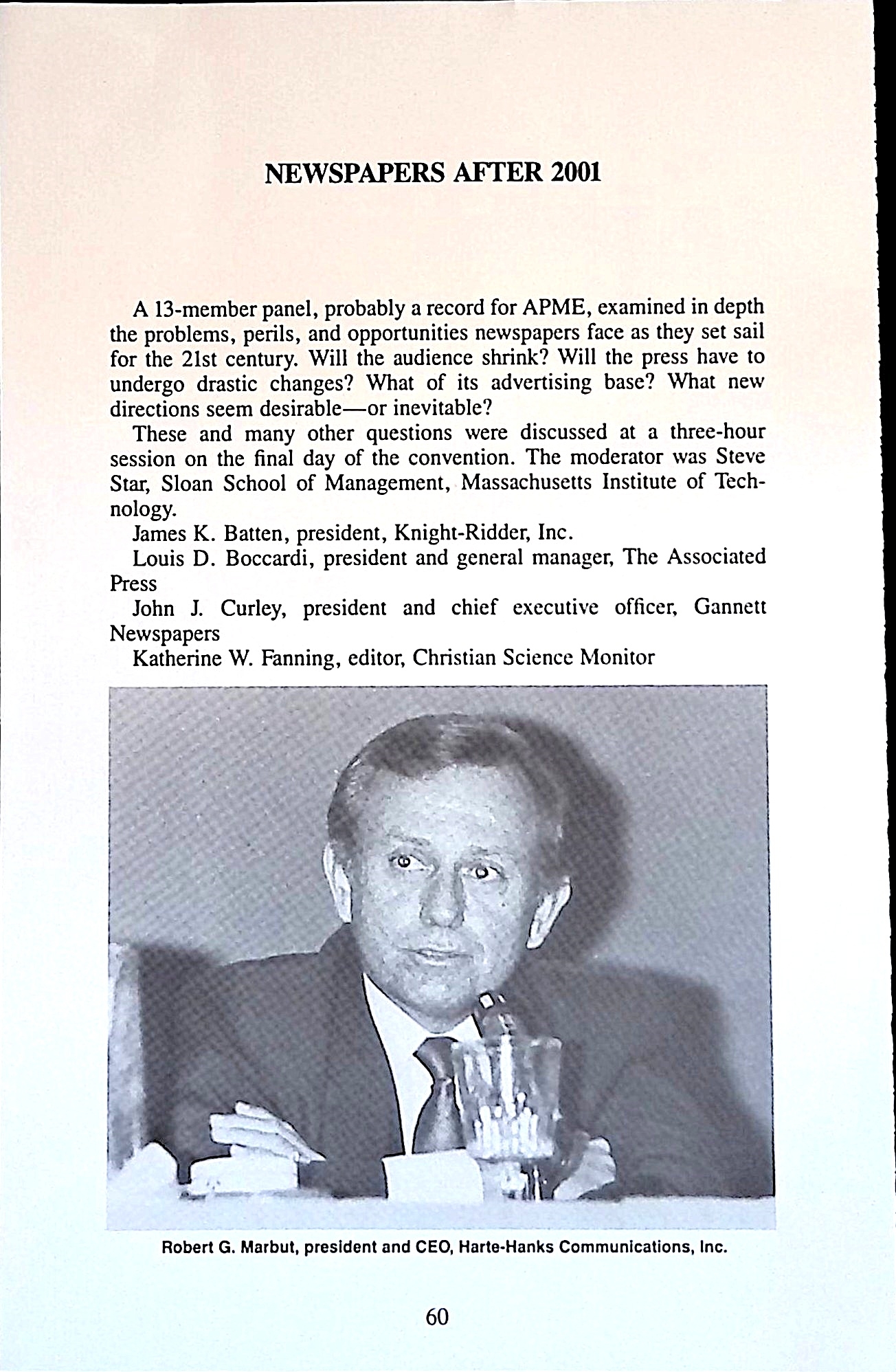Looking to the Future: 1986 to 2001
In the past, journalism conventions serving management and editors, such as the Associated Press Managing Editors conference, were major events. Hundreds of participants, dozens of panels and speeches. So important that the APME published what the called the “Red Book.” This was a record of the proceedings so those who could not attend would learn what was discussed.
In 1987, the Red Book reported on a panel held in Cincinnati, OH, on “Newspapers After 2001.” The panel was tasked to look ahead 15 years. Among the participants:
- James K. Batten, president, Knight-Ridder, Inc.
- Louis D. Boccardi, president and general manager, The Associated Press
- John J. Curley, president and chief executive officer. Gannett Newspapers
- Katherine W. Fanning, editor, Christian Science Monitor
- Jeff Greenfield, media critic and columnist, ABC
- James Hoge, president, New York Daily News
- C.K. McClatchy, president, McClatchy Newspapers
- Burl Osborne, president, Dallas Morning News
- Eugene C. Patterson, chairman and chief executive officer, Times Publishing Company, St. Petersburg, Fla.
- William O. Taylor, chairman and chief executive officer. Boston Globe
- Chris Urban, Urban and Associates
Reading over this edited transcript of the discussion, I was struck how little the panel got right. In fact, I think most of them missed the speeding “technology bus” that was about to crash into their newsprint based business and scatter their profits and employees to the wind. There was discussion about the declining readership — one panelist suggest the industry encourage literacy — and the fragmented advertising market. There were a couple of notable mentions of technology. Here’s one from Kay Fanning:
We’re being increasingly bombarded by trivia and through the progress of technology it will get worse and worse. With all the world coming to our back door in terms of satellite communications and transportation, the link-up of the global stock market, all aspects of computer networking, newspapers will need a content that offers the citizen a pathway through this hail of trivia. That content will require more substance, more quality, offer more understanding rather than just a lot of information. I believe in the simple bromide of the better mousetrap. If we have a quality that is relevant to the citizens and to the public interest we can easily raise the numbers from 40 to 60 percent.
I did like the comments from John Curley about improving the visuals of newspapers to make them more appealing:
Presentation is part of it too. Color, graphics, and our ability to do more in that area will be important. I don’t mean to pick on the Cincinnati Inquirer, since we own it, but in yesterday’s paper we went 11 pages in the Life Section without a graphic or photo. and a lot of the contents suggested that there could have been some there. I don’t think that is atypical of most newspapers, and it’s a weakness in a lot of our newspapers too.
Curley was the first editor of USA Today, hence he knew about color and graphics. USA Today was launched four years earlier, in 1982. in 1988, the American Press Institute had a major design seminar looking at the future of newspapers. It was called Design 2000. Details are elsewhere on this site. Lots of graphics and color in those prototype newspapers.
TV News’ Future
Also at the convention was Lawrence Grossman, president of NBC News. He gave a talk on “Television News After 2001.” He was sort right when he said:
My thesis is that if you look 15 years ahead to the year 2001, it will be much like what we see now in television news, just as when you look back to 1970, television news was basically like what you’re seeing now.
But take that out a few more years and he was very, very wrong. He got a few things right. It was an interesting read.

 apme convention book 1986 future of newspapers 2001
apme convention book 1986 future of newspapers 2001